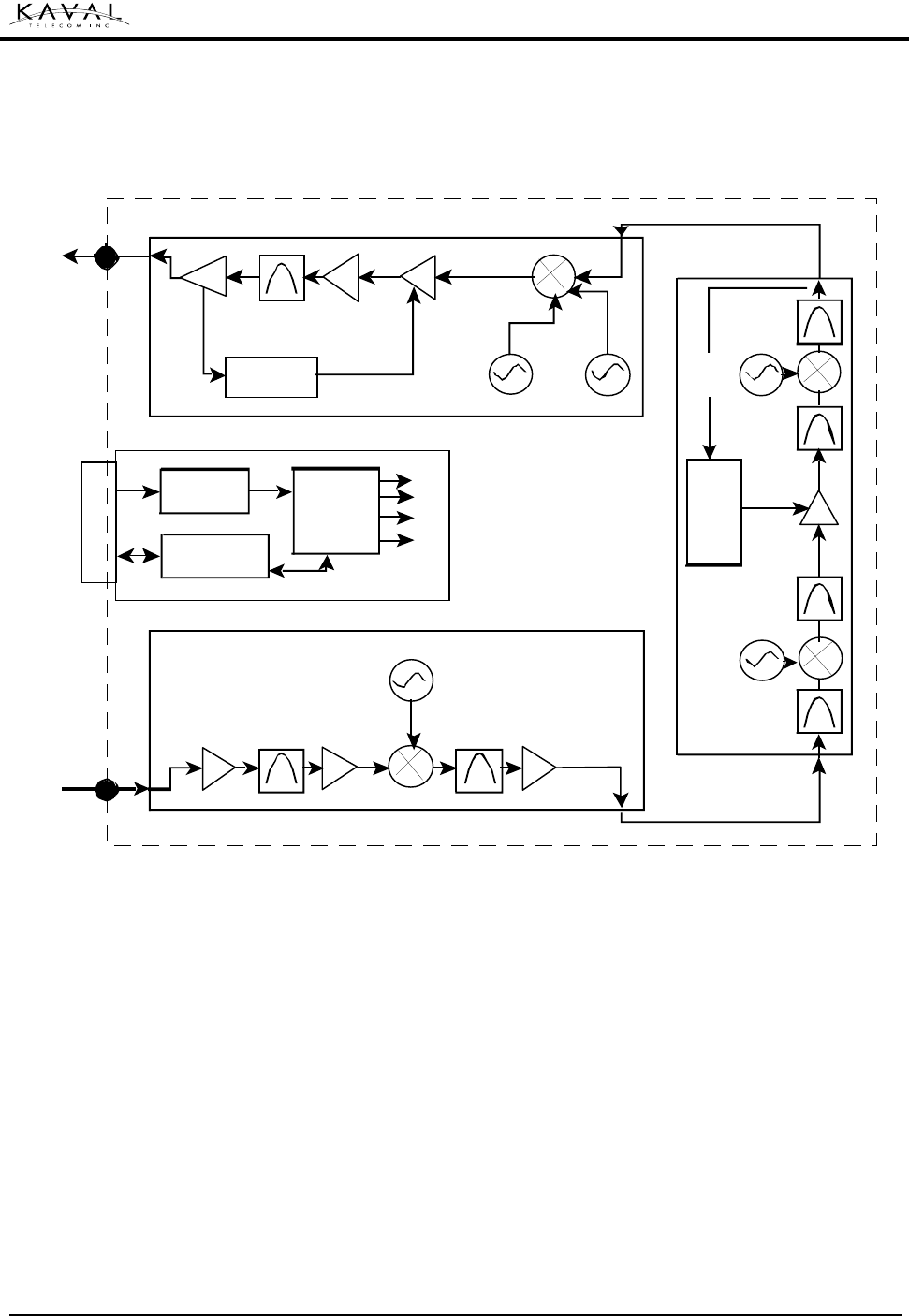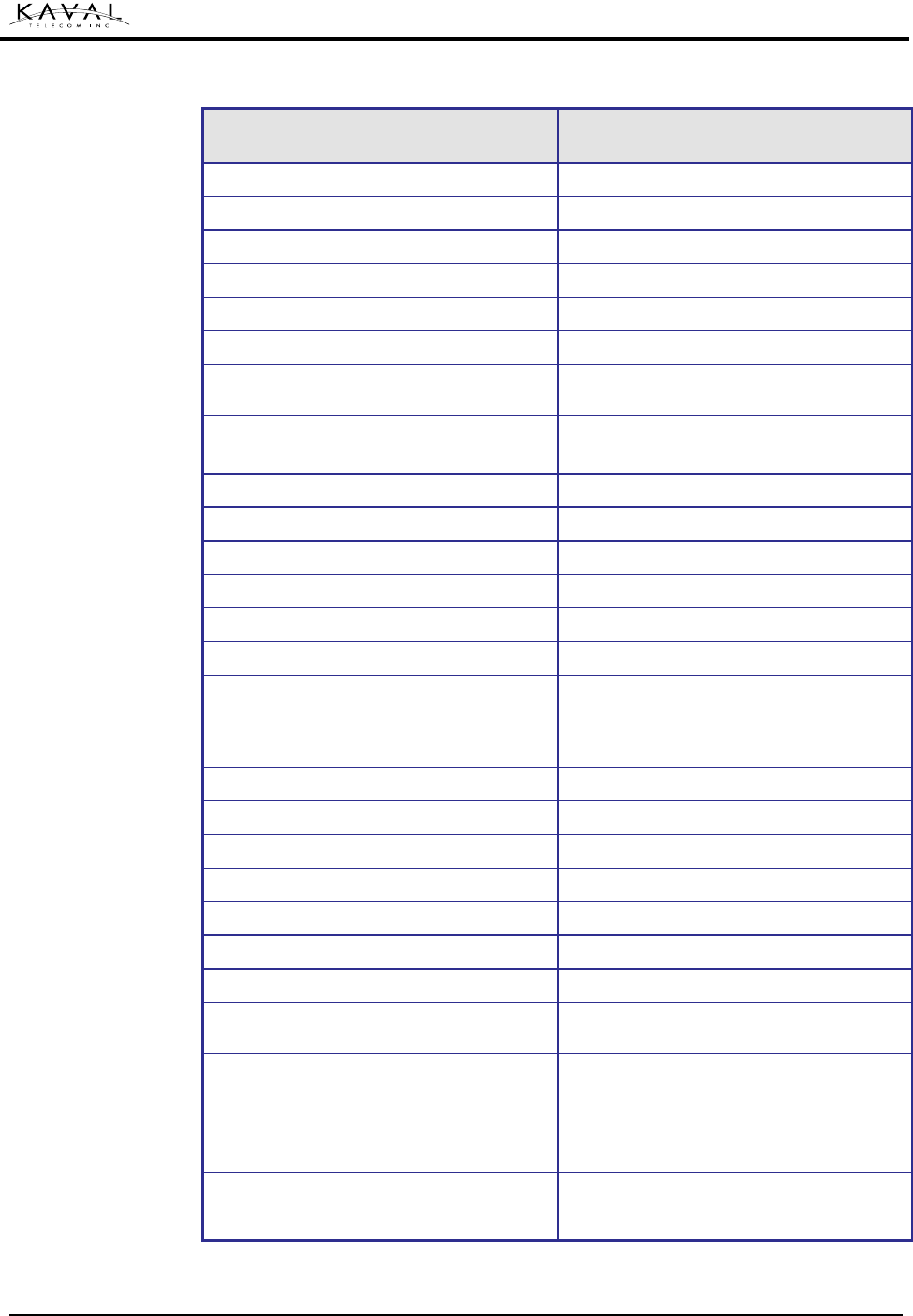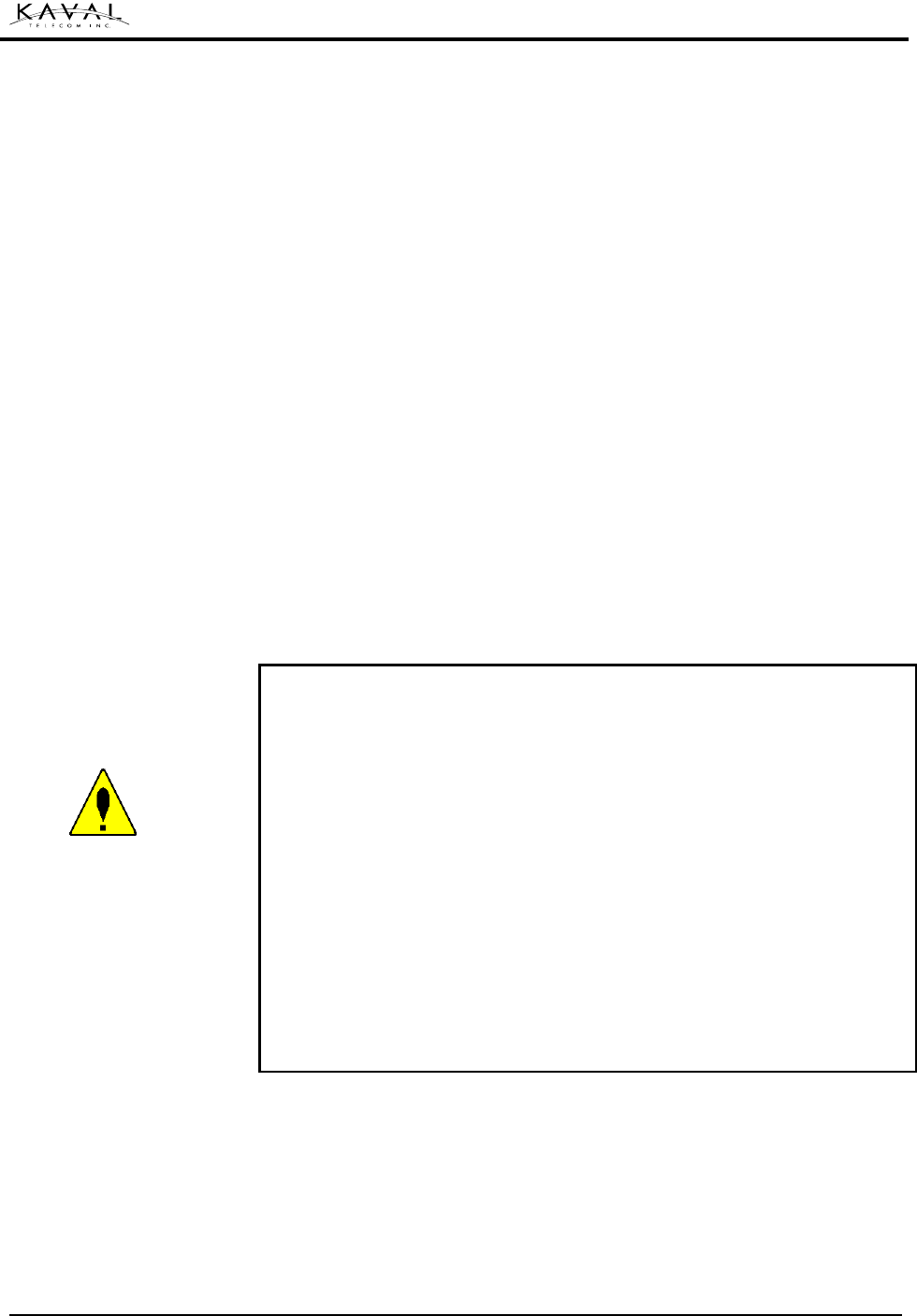Powerwave Technologies OFR400 LINKnet OFR400 RF Repeater Module User Manual users manual part 2
Powerwave Technologies Inc. LINKnet OFR400 RF Repeater Module users manual part 2
Contents
- 1. users manual part 1
- 2. users manual part 2
- 3. users manual part 3
users manual part 2

LINK
LINKLINK
LINK
net
netnet
net
™
™™
™
OFR400 RF MODULES
OFR400 RF MODULESOFR400 RF MODULES
OFR400 RF MODULES
USER MANUAL
USER MANUALUSER MANUAL
USER MANUAL
INSTALLATION, OPERATION
INSTALLATION, OPERATION INSTALLATION, OPERATION
INSTALLATION, OPERATION
AND MAINTENANCE
AND MAINTENANCEAND MAINTENANCE
AND MAINTENANCE
KAVAL TELECOM INC.
60 Gough Road
Markham, Ontario
L3R 8X7
Telephone: (888) 86-KAVAL
Web: www.kaval.com
E-mail: info@kaval.com
Document #DCM000000019, Rev.0

LINKnet™ OFR400 RF MODULES ! USER MANUAL DCM000000019
Printed: 2000-04-11 13:13:34
Revision Date: 4/11/00: ii
P
PP
P
P
PP
PR
RR
R
R
RR
RO
OO
O
O
OO
OP
PP
P
P
PP
PR
RR
R
R
RR
RI
II
I
I
II
IE
EE
E
E
EE
ET
TT
T
T
TT
TA
AA
A
A
AA
AR
RR
R
R
RR
RY
YY
Y
Y
YY
Y
S
SS
S
S
SS
ST
TT
T
T
TT
TA
AA
A
A
AA
AT
TT
T
T
TT
TE
EE
E
E
EE
EM
MM
M
M
MM
ME
EE
E
E
EE
EN
NN
N
N
NN
NT
TT
T
T
TT
T
© 2000 KAVAL TELECOM INC. All rights reserved.
No part of this publication, or any software included with it may be reproduced, stored in a retrieval system,
or transmitted in any form or by any means, including photocopying, electronic, mechanical, recording or
otherwise, without the prior written permission of the copyright holder.
This document contains proprietary information of KAVAL TELECOM INC. The contents are confidential and
any disclosure to persons other than the officers, employees, agents or subcontractors of the owner or
licensee of this document, without the prior written consent of KAVAL TELECOM INC., is strictly prohibited.
KAVAL TELECOM INC. provides this document as is, without any warranty of any kind either expressed or
implied including, but not limited to, the implied warranties of merchantability and fitness of a particular
purpose. KAVAL TELECOM INC. may make changes or improvements in the equipment, software, or
specifications described in this document at any time and without notice. These changes will be incorporated
in new releases of this document.
This document may contain technical inaccuracies or typographical errors. KAVAL TELECOM INC. waives
responsibility for any labour, materials, or costs incurred by any person or party as a result of using this
document. KAVAL TELECOM INC., and any of its affiliates shall not be liable for any damages (including,
but not limited to, consequential, indirect or incidental, special damages or loss of profits or date) even if they
were foreseeable and KAVAL TELECOM INC. has been informed of their potential occurrence, arising out of
or in connection with this document or its use.

LINKnet™ OFR400 RF MODULES ! USER MANUAL DCM000000019
Printed: 2000-04-11 13:13:34
Revision Date: 4/11/00: iii
R
RR
R
R
RR
RE
EE
E
E
EE
EV
VV
V
V
VV
VI
II
I
I
II
IS
SS
S
S
SS
SI
II
I
I
II
IO
OO
O
O
OO
ON
NN
N
N
NN
N
R
RR
R
R
RR
RE
EE
E
E
EE
EC
CC
C
C
CC
CO
OO
O
O
OO
OR
RR
R
R
RR
RD
DD
D
D
DD
D
Rev. № Page № Description of Revision Date
0 All Original Release Apr.6,2000
T
TT
T
T
TT
TR
RR
R
R
RR
RA
AA
A
A
AA
AD
DD
D
D
DD
DE
EE
E
E
EE
E
M
MM
M
M
MM
MA
AA
A
A
AA
AR
RR
R
R
RR
RK
KK
K
K
KK
K
N
NN
N
N
NN
NO
OO
O
O
OO
OT
TT
T
T
TT
TI
II
I
I
II
IC
CC
C
C
CC
CE
EE
E
E
EE
E
This manual makes reference to trademarks that are the property of other companies. References are used
only to refer to the products or services of the trademark owners.
LINKnet™ is a trademark of KAVAL TELECOM INC.

LINKnet™ OFR400 RF MODULES ! USER MANUAL DCM000000019
Printed: 2000-04-11 13:13:34
Revision Date: 4/11/00: iv
TABLE OF CONTENTS
TABLE OF CONTENTSTABLE OF CONTENTS
TABLE OF CONTENTS
1. OFR400 MODULES.................................. 4
OVERVIEW ............................................................. 4
Theory Of Operation......................................... 4
MODELS................................................................. 4
BLOCK DIAGRAM..................................................... 5
OFR400 RF Module ......................................... 5
MODULE SPECIFICATIONS ....................................... 6
OPERATION............................................................ 7
Software Set-up ................................................ 7
Power On Self Test (POST) ............................. 8
Normal Operation ............................................. 9
OFR Drawing (Sides and Top) ....................... 10
ANTENNA INSTALLATION........................................ 11

LINKnet™ OFR400 RF MODULES ! USER MANUAL DCM000000019
Printed: 00.04.11,13:13
Revision Date:4/11/00 4
Theory Of Operation
An OFR, or On Frequency Repeater, is a radio repeater that simultaneously
receives and transmits a single narrow band radio channel on exactly the same
frequency.
The OFR accomplishes its repeater function without store and forward circuitry, or
expensive conventional simulcasting techniques. The fact that the same frequency
is retransmitted by an OFR means that additional frequency allocations are not
required in situations where an existing radio coverage pattern needs to be
extended. The most common OFR applications are the extension of above ground
signals into buildings, tunnels, vehicles or the extension of radio coverage patterns
into outdoor shaded areas such as deep valleys.
From an applications standpoint, an OFR is very similar to a regular two-way radio
repeater. On Frequency Radio Repeaters can be combined using regular two-way
radio multicoupling or duplexing equipment and have input and output signal
characteristics to those of regular transmitters and receivers. The one special
consideration in OFR systems is that of input to output antenna isolation. This must
be carefully engineered for each installation.
Standard On Frequency Radio Repeaters are designed for indoor use only and are
intended for mounting in a standard EIA 19 inch rack. Modular design of OFR
circuitry allows for easy servicing, stocking of spares, adaptability and upgrade
ability.
OFR400 MODULE FAMILY
MODEL TYPE FREQUENCY
OFR400-A1 25 KHz Channels 403-430 MHz (FM)
OFR400-A2 12.5 KHz Channels 403-430 MHz (FM)
OFR400-B1 25 KHz Channels 430-450 MHz (FM)
OFR400-B2 12.5 KHz Channels 430-450 MHz (FM)
OFR400-C1 25 KHz Channels 440-470 MHz (FM)
OFR400-C2 12.5 KHz Channels 440-470 MHz (FM)
OFR400-D1 25 KHz Channels 470-490 MHz (FM)
OFR400-D2 12.5 KHz Channels 470-490 MHz (FM)
OFR400-E1 25 KHz Channels 490-512 MHz (FM)
OFR400-E2 12.5 KHz Channels 490-512 MHz (FM)
1. OFR400 MODULES
Overview
Models

LINKnet™ OFR400 RF MODULES ! USER MANUAL DCM000000019
Printed: 00.04.11,13:13
Revision Date:4/11/00 5
OFR400 RF Module
Block diagram
Transmit Board
UMC Controller Board
Receive Board
IF Board
RF Input
403- 512 M H z
RF Output
403- 512 M H z
Micro-
Controller
with lines to
all Boar ds
Blind-Mate
to SMA RF
Connector
Blind-Mate
to SMA RF
Connector
Power &
Control to
Backplane
Gain Control
Comm unication
Interfaces
Gain
Control Test
Oscillator
Low Noise
Pre-Amplifier Buffer
Amplifiers
2'nd Local
Oscillator
First Local
Oscillator
Buffers, Filters, and
Linear Power Amplifier
Power
Circuits
First Local
Oscillator
2' nd IF
Crystal
Filter
First IF
Filter
First IF
Filter
2' nd IF
Crystal
Filter
2'nd Local
Oscillator

LINKnet™ OFR400 RF MODULES ! USER MANUAL DCM000000019
Printed: 00.04.11,13:13
Revision Date:4/11/00 6
SPECIFICATION
Frequency Bands 403-512 MHz in 5 Bands
Channel Spacing 25 or 12.5 KHz
Modulation Types Narrowband FM
RF Frequency Stability Tracks Input Signal Exactly
Adjacent Channel Selectivity 60 dB Minimum
Max. RF Output Power 37 dBm
RF Output Power Range Power can be reduced 20 dB in 1 dB Steps (AGC
Controlled)
RF Output Power Variation vs. Input
(over -90 to -30 dBm) 0 TO +1 dB
Input Dynamic Range -110 to -30 dBm
Input Sensitivity Adjust Range -110 to -30 dBm
Input Hysteresis 1 to 10 dB
Transmit Duty Cycle Continuous
Transmit Spurious Output -13 dBm max
Receive Conducted Spurious Output -57 dBm Max
Maximum Gain 140 dB
Audio Distortion & Noise
(Narrowband FM) <3% Increase
Transmit Key-Up Time < 2 mS
Transmit Key-Down Time < 1 mS
Group Delay <120 uS
Input / Output Connectors SMA Connectors on back of Card-Cage
Input / Output Impedance 50 Ohms
Module Power Supply Requirements +12V & +28V from Card-Cage Power Supply
Module Power Consumption 45 W Maximum
Connections to Card-cage Edge Connector for Power and Data and Two
Blind-Mate RF Connectors
Front Panel Indicators Operating, Stand by, Fault, Program Mode,
Receive, Transmit
Module Interconnections (via Card-Cage)
DB-15 Connector on back of Card-Cage provides
per-Module Fault Relay, Interconnect to other
Modules, & RS-232 connection to a PC.
Configuration Options
RF Modules may be configured either via the
optional Controller Module, or via a PC and an
RS-232 Connection via the Card-Cage.
Module Specifications

LINKnet™ OFR400 RF MODULES ! USER MANUAL DCM000000019
Printed: 00.04.11,13:13
Revision Date:4/11/00 7
SPECIFICATION
Size 9.11” High, 2.00” Wide, 14.00” Deep
Weight 10 lbs, 4.5 kg Max
Software Set-up
The OFR400 module is shipped pre-configured with the following factory set options:
OPTION RANGE OF VALUES DEFAULT VALUE
Frequency 403 – 512 MHz
(As per Model) Order Specific
Receive Threshold –110 to -50 dB -89 dB
Receive Hysteresis 1 to 10 dB 2.5 dB
Hang Time 0.0 to 5.0 Seconds 2.0 Seconds
Time Out 0 to 600 Seconds
Or none 300 Seconds
Module Enabled On / Off On
Transmit Power Level 20 to 37 dBm Order Specific
In line with the versatility of the LINKnetTM Platform, it is possible to re-configure the
OFR400 module in the field. For further information on the modification software
and the PC adapter, contact KAVAL TELECOM INC. by E-mail: info@kaval.com
Default values may be changed when an order is placed. Check your order
confirmation (shipped with modules) for customized values.
Operation

LINKnet™ OFR400 RF MODULES ! USER MANUAL DCM000000019
Printed: 00.04.11,13:13
Revision Date:4/11/00 8
Power On Self Test (POST)
Each system module automatically performs a self-diagnostics when inserted into
the system Card-cage. These tests determine that the unit is a) correctly installed in
the Card-cage and b) not damaged in transit.
• All six of the LED’s on the front panel will flash 3 times
• If the LED’s do NOT flash three times, then remove the module, check the power
source, and re-insert the module, (See Installation Instructions).
• If the card is “OK” the LED’s will continue normally. (See Normal Operation)
• If there is a fault, then the Red Fault LED will remain on. If this occurs, contact
your KAVAL TELECOM INC. Service Representative, (See Warranty / RMA
Procedures).
The Power On Self Test is Not an RF test, it only verifies that there is power to
the unit and that the logical circuitry is functioning.

LINKnet™ OFR400 RF MODULES ! USER MANUAL DCM000000019
Printed: 00.04.11,13:13
Revision Date:4/11/00 9
Normal Operation
The OFR400 Module has six LED’s on the faceplate:
1. OPERATING - Under normal operating conditions, this LED will flash
GREEN when RF Data is present.
2. STAND BY – Under the control of the Controller Module, the OFR400
Module has the ability to act as a duplex transmitter, sitting perpetually in
Stand by Mode waiting for the primary transmitter to fail. This LED should be
constant Amber. If a Fault should occur with the primary module, the “Stand
by” unit will immediately become the primary unit, at which time the Stand
by LED will be turned off and the LED’s will show an operating Module.
3. Transmit – This Green LED will be on when a signal is being transmitted
4. Receive – This Green LED will be on when a signal is being received
5. Program – This LED will be constant Amber when the unit is being re-
programmed by the Controller Module. This will signify that the unit is
powered on but unavailable for use.
6. FAULT – Red LED, If the internal diagnostics for the module detect a
problem, then this LED will remain on

LINKnet™ OFR400 RF MODULES ! USER MANUAL DCM000000019
Printed: 00.04.11,13:13
Revision Date:4/11/00 10
OFR Drawing (Sides and Top)
OFR400 Module

LINKnet™ OFR400 RF MODULES ! USER MANUAL DCM000000019
Printed: 00.04.11,13:13
Revision Date:4/11/00 11
• All Antenna Installation is to be performed by Qualified Technical Personnel only.
• Antenna Installation Instructions and locations below are for the purpose of
satisfying FCC RF Exposure Compliance requirements.
• The Roof Top Antenna for linking to the Donor Site is a directional (high gain)
Antenna fixed-mounted physically on the side or top of a building, or on a tower.
The Antenna Gain must be no more than 10 dB. The Roof Top Antenna location
should be such that only Qualified Technical Personnel can access it, and that
under normal operating conditions no other person can touch the Antenna, or
approach within 10 meters of the Antenna.
• The In-Building Antenna connection is via a coaxial cable distribution system with
Signal Taps at various points connected to the fixed-mounted Indoor Antennae.
This is shown in the figure in the Introduction. The Indoor Antennae are simple
1/4 Wavelength (0 dB Gain) types. They are used with KAVAL TELECOM INC.
12, 16, or 20 dB Cable Taps. As such the maximum EIRP will be at the first
Tapped Antenna, which will be 12 dB below the maximum signal level of the
LINKnet™ (+37 dBm); +28 dBm, or 0.63 Watts EIRP. These Antennae are to be
installed such that no person can touch the Antenna, or approach within 0.2
Meters.
ANTENNA INSTALLATION
WARNING
ALL ANTENNA INSTALLATION IS TO BE PERFORMED BY QUALIFIED
TECHNICAL PERSONNEL ONLY.
ANTENNA INSTALLATION INSTRUCTIONS AND LOCATIONS ARE FOR
THE PURPOSE OF SATISFYING FCC RF EXPOSURE COMPLIANCE
REQUIREMENTS, AND ARE NOT OPTIONAL.
ALL ROOF TOP ANTENNA INSTALLATION MUST BE SUCH THAT NO
PERSON CAN TOUCH THE ANTENNA, OR APPROACH CLOSER THAN
10 METERS.
ALL IN-BUILDING ANTENNAE INSTALLATIONS MUST BE SUCH THAT
NO PERSON CAN TOUCH THE ANTENNAE, OR APPROACH CLOSER
THAN 0.2 METERS.
Antenna Installation